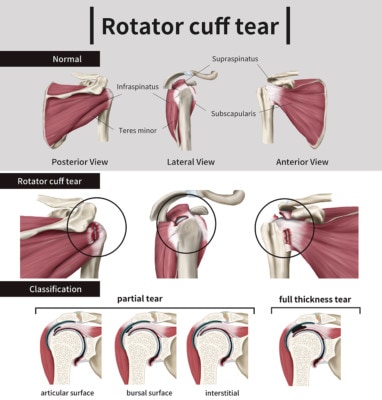Surgery for Big Rotator Cuff Tears Has High Retear Rates…
Rotator Cuff tears can be tricky. I think to best understand them, you need to ask your self why they happen in the first place. While some result from trauma, the vast majority of rotator cuff tears happen from simple wear and tear as we age. Why would the most important group of muscles in the shoulder fail, and when surgically repaired, do these repairs hold? A recent large review study doesn’t demonstrate much confidence in long term results, given arthroscopic rotator cuff surgery retear rates.
So what exactly is the Rotator Cuff? The rotator cuff is a complex series of muscles around the shoulder that help to lift the arm and stabilize the ball in the socket. Surprising to most people, the most common scenario for a tear to occur is simply one slightly more demanding movement than usual. How could that happen? It’s been known for a considerable amount of time that the rotator cuff doesn’t have the best blood supply, but blood supply varies to many areas of the body. The problem is actually a lack of healthy progenitor cells and stem cells to repair the damage as it occurs overtime, and at some point with little provocation, the damaged tissue simply fails and a tear occurs. Therefore, sewing together failing tissue which has not been able to heal doesn’t make a lot of sense. In addition, the prolonged bracing needed after the rotator cuff surgery causes those same muscles to atrophy, further disrupting the area’s healing capability. Rather than causing extensive trauma to an already failing area, the tissue first needs to have its regenerative potential restored. This is what stem cell injections accomplish and both in our clinical experience, and recent studies, even many of these “massive” tears will heal themselves without the need for surgery once the local repair response is augmented with more stem cells.

Chu KyungMin/Shutterstock
The study was a large systematic review study of 18 papers following patients pre and post operatively who had “massive” rotator cuff tears. 954 patients, ages 37-87, half men and half women whose symptoms occurred an average of 2 years before surgery, of whom 81% had complete tears and 19% partial tears, were followed for 33 to 54 months. The results were concerning. While the surgery in many cases helped in the short term, the retear rate was a staggering 81%!
The upshot? This was a large study whose results demonstrated what we already know. In most circumstances, the logic behind rotator cuff surgery is flawed. Attempting to fix something which is torn by further weakening it and expecting it to hold is illogical at best. Giving the area what it’s actually missing by using your own stem cells and not creating additional trauma or atrophy, simply makes more sense. If you know someone who has a rotator cuff tear who meets the inclusion and exclusion criteria of the Regenexx Rotator Cuff Stem Cell Study, they might be eligible for a Regenexx Rotator Cuff repair at no cost to them.

If you have questions or comments about this blog post, please email us at [email protected]
NOTE: This blog post provides general information to help the reader better understand regenerative medicine, musculoskeletal health, and related subjects. All content provided in this blog, website, or any linked materials, including text, graphics, images, patient profiles, outcomes, and information, are not intended and should not be considered or used as a substitute for medical advice, diagnosis, or treatment. Please always consult with a professional and certified healthcare provider to discuss if a treatment is right for you.
